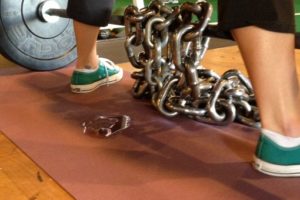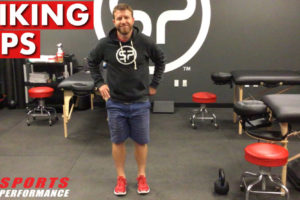Agility ladders.
They are like an icon of speed — we see athletes hit the ladder hard in the name of getting faster and more agile. But is that what the agility ladder really does? Well, not really.
Agility is the ability to quickly change body position and/or direction. It is the totality of decision-making combined with the physical and technical aspects of deceleration, acceleration, and the change of direction/movement. The average ladder drill moves in one direction (straight forward, or sideways) at a constant speed. While the tap dance appearance can look impressive, what are we really trying to accomplish?
It is the totality of decision-making combined with the physical and technical aspects of deceleration, acceleration, and the change of direction/movement.
If used correctly, the ladder can be a useful tool. Rather than speed and agility, we are training body awareness, control, and coordination — proprioception. The amazing physical feats we see athletes perform with their ability to overcome poor positions is a result of the connections between the brain and muscles that are made permanent through practice. It takes thousands of repetitions of doing a certain movement CORRECTLY in order to be able to do it properly and without thinking. Lacking control and awareness of the body increases the potential for injury. Performing ladder drills is also one of the steps in developing tendon elasticity – the recoil effect that helps us to run, jump, lift, and absorb impact. The repetitive action of loading and unloading the legs is a great dynamic warm up to prepare for eccentric strength training, plyometrics, and explosive isometrics. So, the ladder can be extremely beneficial when used in rehab, off-/preseason, injury prevention, or general physical preparation training.
Rather than speed and agility, we are training body awareness, control, and coordination — proprioception.
The little things we are looking for when working through ladder drills are the ability to work through progressively more difficult foot patterns and to increase speed through each drill. Starting slow allows athletes to learn how to maintain posture and hip height, control where the foot will land, how much force each foot will land with, how long the foot stays in contact with the ground, and in what direction the body will move next. Learning and practicing this will make movement more efficient.
Learning and practicing this will make movement more efficient.
Efficient movement means that energy won’t be wasted. Less time and energy to complete some sort of athletic task means that you are faster. Imagine that you or your athlete are able to control the body quickly change direction with a cross-over step, while running a stop-and-go route, or getting the jump on stealing second base. Body awareness and control with sports-specific movement starts with general training tools such as the agility ladder.
Efficient movement means that energy won’t be wasted.
Be there, be gone, and win with each step.
As always, I hope this helps! If you have any questions or would like to read about certain topics, send us an email at TeamSP@SportsPerformancePT.com.
-Shane Adamos, MS, CSCS, CF-L1
For more tips on optimizing athletic performance FOLLOW US on:
- Instagram: http://www.instagram.com/SportsPerformancePT
- Facebook: http://www.facebook.com/SportsPerformancePT
- YouTube: http://www.youtube.com/c/SportsPerformancePT











